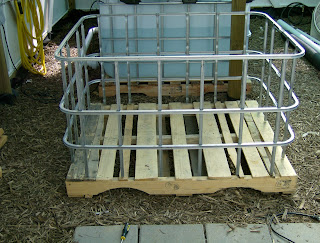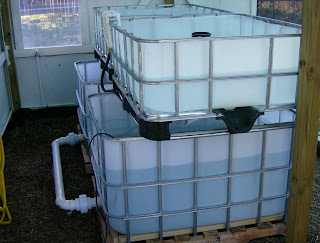First step in prepping these totes for use in an Aquaponics system is to remove the top retaining brackets as shown in the photo below. The screws take a large Torqs Bit, which I did not have, but an alternate was to use a Hex bit which fit nicely in the head of each retaining screw.
Moving on, the next item on the list is to remove the plastic tank from the cage, which can be accomplished by laying the whole unit on it's side and sliding the tank out of the cage.
Before cutting up the frame for the various pieces needed in the Aquaponics system. I took a pressure washer and sprayed out the inside of the plastic tanks as a precursor to cleaning them after prepping the cage.
On to the cage/frame prep. I used a metal cutoff blade in my old trusty B&D 7-1/4" circular saw to cut the metal tubing on the cage. Cuts were made all the way around the cage at the second horizontal cross member as shown below.
After cutting is complete on the cage, I had to cut a whole in the center of the base for the PVC piping that would have to protrude through to the fish tank as the bottom of the cage would now be the base for my grow bed. Using the circular saw I cut out an approximate 4" x 6" opening in the base.
After this, I took a 4-1/2" angle grinder and took off any visible burrs around the opening and also on each vertical brace of the cage where I cut the cage into two pieces.
After this, it was on to cutting the plastic tote into two pieces. In order to do this the tote would have to be turned upside down and placed back in the base without the scew-on 6" lid in place. Once in place, I took a felt tipped marker and drew a line around the plastic tote at the top of horizontal cross member.
After marking the line around the tote, I removed it from the base and laid it on it's side. In order to cut the tote, I purchased a 120 Tooth plastic/vinyl blade for $10 from my local Lowe's Home Improvement store.
Here is the finished product.
At this point I spent the next two hours cleaning the inside and outside of the tanks. Removing any residue left by the pre-wash by using a combination of Crude Cutter Cleaner, TSP, the pressure washer and good old hand scrubbing. Once this was done I moved on to prepping the wooden pallets as a base to accept the larger cage for the Fish Tank I simply placed the pallet where I wanted it to go, and then attached 2"x2' furring strips to the pallet inside the cage perimeter as shown, which hold the cage in place while providing an easy breakdown if it needs to be moved.
All that was left for the major assembly was to place the large half of the Tote Tank into the pallet base which would serve as the Fish Tank, while placing the Metal Base on top of the palletized tote for use as the grow bed.
The top tanks are approximately 15" deep which is perfect for a 12" grow bed. I intend to use Growers Stone which is an inert lightweight material which looks similar to lava rock as a growing medium. Next it's on to the Affnan Bell Siphon, which is made out of 1" PVC pipe and along with a 1-1/4" reducer coupling SxT, 1" female adapter, 2" Male Adapter, and two reducer bushings, one is a 2x1", and the other is a 1-1/2x1" reducer.The last three items are actually glued together and screwed into the 6" screw on cap which the 1" standpipe/bell siphon attaches to. I also used 3" PVC for the bell portion of the siphon with a 3" plastic test cap glued in place with corresponding diagonal cuts on the bottom to break the siphon once the water reaches the bottom of the grow bed. Lastly, I used 4" perforated corrugated drain pipe over the whole siphon to protect it from the gravel in the beds, and to provide better water circulation.
Here is what the whole set-up looks like when put together.
The above picture also shows the ebb & flo growbed in action. I timed the fill at approx. 25 minutes per 200 gallons of water, so for two grow beds in each system with a full compliment of grower stones which will displace approximately 50% of the water in each bed, that cuts the time down to less than 15 minutes, with a drain lasting approximately 5 minutes I should be able to get 3 cycles per hour, not optimum, should be 4, but three will do.
With the 1-1/4 reducer, it takes approx. 25 seconds for a full force siphon to start. I may try to order the 1-1/2 reducers as my local home improvement & hardware stores don't carry them. This would reduce the siphon start time to approx. 5-7 seconds. I used a 600 GPH magnetic drive submersible utility pump with an attached pre-filter to supply water to two tanks at a time.
In order to do this I had to connect the two tanks together. I decided to use the existing 2" ball valves that were attached to the totes from the factory as each one has 2" IPS threads which will accept a 2" female PVC adapter. To this I attached a 2" PVC Union and 2" 90 degree DWV elbows and 2" PVC pipe between each tank for the connection as shown in the next photo. This gives me the added ability to remove the connection and drain/clean or work on individual tanks when needed.
In order to feed water to each grow bed I came up with a PVC manifold using 1/2" PVC pipe and fitting.
This was attached to the pump with a section of black UV resistant 5/8" card hose.
and here is the system at it's present stage of completion. I am in the process of adding two more Fish Tanks/Grow beds for a total of four in the greenhouse.
I still have to add an air system to the tank for Dissolved Oxygen (DO) in the tanks, along with a way to heat the water in the winter and cool it in the summer, perhaps a pond heater and a Chiller are in my future. I will save that for upcoming post....hope you have enjoyed the journey so far. Until next time...




























Great job on this !
ReplyDeletewhat not connect the ibc totes and make wooden pond liner grow beds?seems like a waste cutting the totes for such a small grow beds
ReplyDeleteI'm getting 4 ibc totes tomorrow. I want this exact same setup. I stumbled on this after 2 hours of looking. I would like some more info if possible. I'm not very bright on this stuff but catch on fast. I'm real new to aquaponics lifestyle. Like I said above I want this same setup with four total in a 8x12 greenhouse. If u could help I would be forever greatful. My email is tjharrell73@gmail.com. thanx and great job.
ReplyDeleteThis is awesome! I've been struggling a lot in deciding to use rubbermaid 300 gal containers, barrels, etc. This looks very cost efficient and simple!
ReplyDeleteThanks
Why did you use the steel pallet for the grow bed rather than the fish tank?
ReplyDeleteI would think it would be stronger.
David